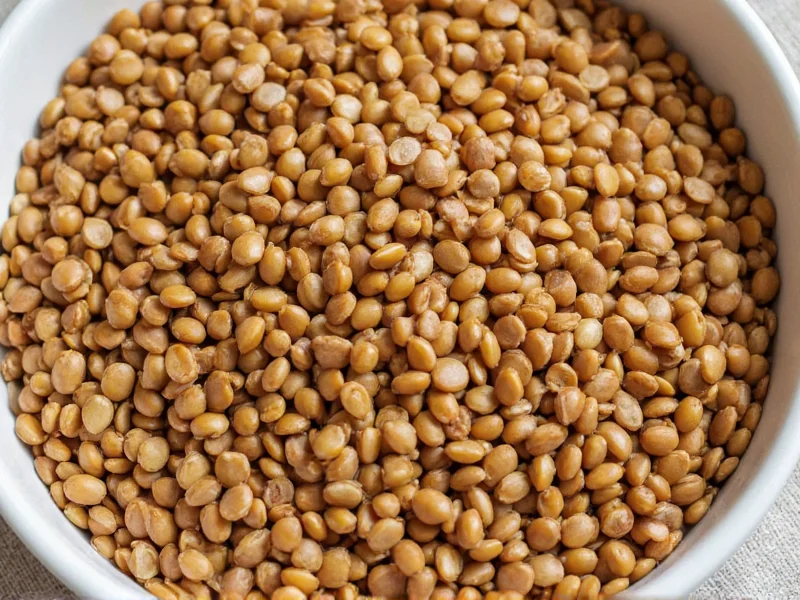When evaluating plant-based protein options, lentils consistently emerge as a nutritional powerhouse. These legumes provide not only substantial protein but also essential fiber, iron, and folate. A single serving delivers nearly one-third of your daily protein needs while remaining low in fat and free of cholesterol.
Nutritional Profile of Lentils
Lentils stand out among legumes for their protein density and quick cooking time. Unlike many beans, they don't require pre-soaking, making them exceptionally convenient for high-protein meal preparation. The protein content varies slightly by lentil variety, but all types offer impressive nutritional benefits.
| Lentil Type | Protein (per cooked cup) | Calories | Fiber (g) |
|---|---|---|---|
| Brown/Green Lentils | 18g | 230 | 15.6 |
| Red/Yellow Lentils | 17.9g | 216 | 15.3 |
| Black (Beluga) Lentils | 18.1g | 224 | 15.7 |
| Puy Lentils | 17.8g | 228 | 15.2 |
How Lentils Compare to Other Protein Sources
Understanding where lentils rank among protein sources requires context. While animal proteins generally contain more protein per serving, lentils outperform many plant alternatives. For those following vegetarian or vegan diets, lentils provide a critical protein foundation.
When comparing lentils protein content per 100g to other foods, cooked lentils deliver about 9g of protein per 100g. This exceeds most grains and many vegetables, though it falls below soy products like tofu (8g per 100g) and tempeh (19g per 100g). Compared to animal proteins, a 100g serving of chicken breast contains approximately 31g of protein.
The quality of lentil protein matters as much as the quantity. Lentils contain all nine essential amino acids, though methionine appears in lower amounts. Combining lentils with grains like rice creates a complete protein profile comparable to animal sources—a crucial consideration for plant-based diets.
Maximizing Protein Absorption from Lentils
To optimize the protein benefits of lentils, consider these evidence-based strategies:
- Pair with vitamin C-rich foods: Adding tomatoes, bell peppers, or citrus to lentil dishes enhances iron absorption, which supports protein utilization
- Combine with grains: Rice, quinoa, or whole wheat bread complements lentils' amino acid profile
- Include healthy fats: Olive oil or avocado helps absorb fat-soluble vitamins that support protein metabolism
- Soak before cooking: Reduces phytic acid, which can inhibit mineral absorption
Common Misconceptions About Plant Protein
Many believe plant proteins are inherently inferior to animal proteins, but this oversimplification ignores important nutritional context. While animal proteins typically contain higher concentrations of complete protein, plant proteins like lentils offer additional benefits including fiber, phytonutrients, and lower saturated fat.
Research shows that diverse plant protein sources, when properly combined, can meet all protein requirements for healthy adults. The key is understanding how different plant foods complement each other—a concept known as protein combining. Lentils serve as an excellent base for such combinations.
Practical Applications for High-Protein Diets
Incorporating lentils into high-protein meal planning requires minimal effort. Try these approaches:
- Replace half the ground meat in recipes with cooked lentils to boost fiber while maintaining protein content
- Create protein-packed salads using Puy lentils, which hold their shape well after cooking
- Blend cooked red lentils into soups and sauces for added nutrition without altering flavor significantly
- Use lentil flour in baking for a protein boost in pancakes and flatbreads
For athletes and active individuals monitoring their protein intake, understanding how much protein in cooked lentils helps with precise meal planning. A standard cup provides sufficient protein to support muscle maintenance when combined with other protein sources throughout the day.
Conclusion
Lentils represent one of the most efficient plant-based protein sources available, offering substantial protein content alongside valuable micronutrients and fiber. While they don't contain the highest protein concentration compared to all food sources, their nutritional completeness, versatility, and accessibility make them indispensable for vegetarian, vegan, and health-conscious diets. By understanding lentils protein content per serving and implementing smart pairing strategies, individuals can effectively leverage this ancient legume to meet their dietary protein requirements.
How does lentil protein compare to meat protein?
Lentils provide about 18g of protein per cooked cup compared to approximately 30-35g in a similar serving of lean meat. While meat contains more protein per serving and is a complete protein, lentils offer additional fiber and complex carbohydrates without saturated fat. When combined with grains, lentils form a complete protein profile comparable to meat.
Are lentils a complete protein source?
Lentils contain all nine essential amino acids but are lower in methionine. When consumed with grains like rice or wheat, which are higher in methionine but lower in lysine, they form a complete protein profile. This complementary protein pairing makes lentils an excellent foundation for vegetarian and vegan diets.
Which lentil variety has the highest protein content?
Black (Beluga) lentils contain slightly more protein at 18.1g per cooked cup compared to other varieties. However, the difference is minimal—brown, red, and Puy lentils all provide between 17.8-17.9g per serving. All lentil types offer excellent protein content with minor variations in texture and cooking properties.
How much protein do I get from 100g of cooked lentils?
Cooked lentils contain approximately 9g of protein per 100g serving. This makes them one of the highest protein plant foods available, outperforming most vegetables and grains. For comparison, the same amount of cooked chickpeas contains about 8.9g of protein, while black beans provide roughly 8.7g.
Can lentils provide enough protein for muscle building?
Yes, lentils can contribute significantly to muscle-building diets when consumed as part of a varied protein intake. While they don't contain as much protein per serving as animal products, their amino acid profile (when combined with grains) supports muscle protein synthesis. Athletes following plant-based diets often combine lentils with other protein sources like tofu, tempeh, and seitan to meet higher protein requirements.











 浙公网安备
33010002000092号
浙公网安备
33010002000092号 浙B2-20120091-4
浙B2-20120091-4